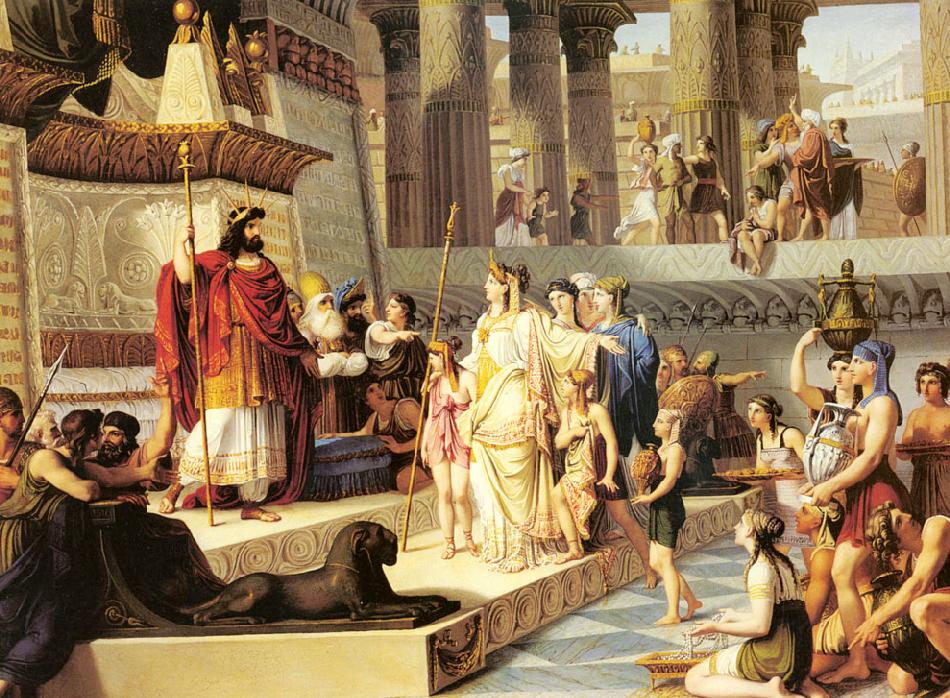
Arabia: Ancient Economy

Figure 1.--The Biblical story of King Soloman and the Qyeen of Sheba substantiates the existence of trade routes between the Levant and the southern Arabian Peninsula on to Ethiopia (about 550 BC). Few Bible stories have generred such widespread interest among academics as well as geberated such intensive literary treatmnt. It is also a subject of religious Chriatian, Jewish, and Islamic scholars. Both European and Ethiopian Christians have shown an interest and countless legends have generated far beyond the Biblical passages. There are noactual period images of the story. There are countless imaginary recreations. This one is 'Solomon and The Queen of Sheba' by Giovanni De Min (1789–1859).
|
|
Much of Arabia is covered by a desolate arid landscape which did not support agricultural. In a world that agriculture was the primnary genrator of wealth, this left the Arabian Peninsula and the people living there poor with little cultural development. Nor was there much in the way of mineral resources. The primary resource that the prople of the Arabian Peninsula had was geography--the location of the Peninsula. The Arabian Peninsula is situated between the Arabian Sea (Indian Ocean) and the Mediterrnen Sea. As there was no sea connection, between the Red Sea and Mediterranean, trade routes criss crossed the Peninsula. These trade routes existed in Biblical times even before the Roman Empire. The King’s Highway was a major trade route in the ancient Near East. It streached from Egypt east across the Sinai Peninsula to Aqaba. From there it turned northward across the Levnt to Damascus and onto Mesopotami and the Euphrates River. There were limitations on this trade because ancient socuties for milnnia only ad the donkey as a beast of burden and donkeys can only carry small loads. They also have limited range without water. Camels changed all this, but only arrived in the Levant in late-antiquity (930-900 BC). [Ben-Yosef and Sapir-Hen] The copper trade may have been what caused this. This period coincides with the invasion of Egyptian Pharoah Sheshonq I (Shishak) (925 BC) and could be related. The camel made possible trade routes into the heart of the Arabian Peninsula. Thus trade routes developed leading south. Israeli researchers write, "Our results have direct implications on dating the beginning of the Arabian trade and the many related economic and social phenomena. As most probably significant trade between southern Arabia and the Levant was not feasible before the use of camels as pack animals, it could not have commenced before the last third of the 10th century BCE.” [Sapir-Hen and Ben-Yosef] These are further suggested by the Biblical accounts of the King Solomon and the Queen of Sheba. [First Kings 10] Biblival scholars date the encounter (about 550 BC). This meant that well-established trading routes extending from Israel not only south to the southern Arabian Peninsula, but on to ancient Ethiopia. Imporant trading ports sprang up all along the perifery of the Arabian Peninsula, the Pesian Gulf, Arabian Sea, and the Red Sea. Trade was the primary economic activity for centuries, both involvement in trade or raiding the merchants involved in the trade. Conflict between the various tribes over control of the trade routes was endemic.
Sources
Ben-Yosef, Erez and Lidar Sapir-Hen. Press release, Tel Aviv University (2013).
Ben-Yosef, Erez and Lidar Sapir-Hen. Journal of the Institute of Archaeology of Tel Aviv University (2013). Sapir-Hen is an archaeozoologist who studies the role of animals in ancient human culture. The camel is mentioned 47times in the Bible. Some of these pasages are in books describing very early points, perhaps 2000-1500 BC as oral history. But is was not until more recent times that they were actually written down and by that time the camel was well established and the people writing it down had no idea when the camel atually appeared.
Old Testament. First Kings
CIH

Related Chronolgy Pages in the Boys' Historical Web Site
[The 1880s]
[The 1890s]
[The 1900s]
[The 1910s]
[The 1920s]
[The 1930s]
[The 1940s]
[The 1930s]
[The 1940s]
[The 1950s]
[The 1960s]
[The 1970s]
[The 1980s]
Navigate the Children in History Website
[Return to the Main Arabian economy page]
[Return to the Main Saudi page]
[Return to the Main country page]
[Return to the Main Middle Easterm country economy page]
[Return to the Main Middle Eastern history page]
[About Us]
[Introduction]
[Biographies]
[Chronology]
[Climatology]
[Clothing]
[Disease and Health]
[Economics]
[Geography]
[History]
[Human Nature]
[Law]
[Nationalism]
[Presidents]
[Religion]
[Royalty]
[Science]
[Social Class]
[Bibliographies]
[Contributions]
[FAQs]
[Glossaries]
[Images]
[Links]
[Registration]
[Tools]
[Children in History Home]
Created: 9:20 AM 5/13/2015
Last updated: 7:54 AM 11/8/2015



